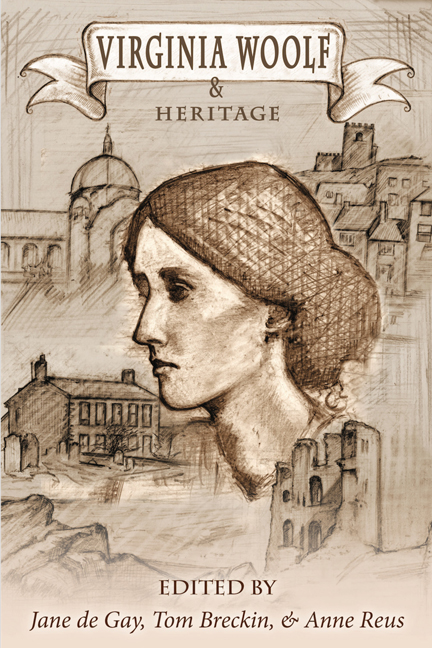Book contents
- Frontmatter
- Contents
- Introduction
- List of Abbreviations
- HERITAGE: A DEBATE
- HERITAGE, EDUCATION, AND MENTORING
- “The Very Centre of the Very Centre”: H. A. L. Fisher, Oxford, and “That Great Patriarchal Machine”
- Virginia Stephen's Uneasy Heritage: Lessons, Readers, and Class
- Teaching Virginia Woolf in Sin City: Vegas Entertainers and a New Feminist Heritage
- Out-takes from Upstarts: Virginia Woolf, Jane Ellen Harrison, and the Heritage of Dissent, or, “There She Wasn't?”
- Virginia Woolf 's Female Heritage: The Legacy of Anny Thackeray Ritchie, Woolf 's “Transparent Medium”
- HERITAGE SPACES
- LITERARY AND CULTURAL HERITAGES
- QUEER PASTS
- MODERNISM AND HERITAGE
- WRITING LIVES AND HISTORIES
- WOOLF'S LEGACIES
- FINALE
- Notes on Contributors
Virginia Woolf 's Female Heritage: The Legacy of Anny Thackeray Ritchie, Woolf 's “Transparent Medium”
from HERITAGE, EDUCATION, AND MENTORING
- Frontmatter
- Contents
- Introduction
- List of Abbreviations
- HERITAGE: A DEBATE
- HERITAGE, EDUCATION, AND MENTORING
- “The Very Centre of the Very Centre”: H. A. L. Fisher, Oxford, and “That Great Patriarchal Machine”
- Virginia Stephen's Uneasy Heritage: Lessons, Readers, and Class
- Teaching Virginia Woolf in Sin City: Vegas Entertainers and a New Feminist Heritage
- Out-takes from Upstarts: Virginia Woolf, Jane Ellen Harrison, and the Heritage of Dissent, or, “There She Wasn't?”
- Virginia Woolf 's Female Heritage: The Legacy of Anny Thackeray Ritchie, Woolf 's “Transparent Medium”
- HERITAGE SPACES
- LITERARY AND CULTURAL HERITAGES
- QUEER PASTS
- MODERNISM AND HERITAGE
- WRITING LIVES AND HISTORIES
- WOOLF'S LEGACIES
- FINALE
- Notes on Contributors
Summary
Like Jean, I want to begin by paying tribute to my own female heritage and to two intellectual, academic, mothers without whose incredible support and mentoring I would not be standing here today. The first is the late, much missed, Julia Briggs, who encouraged me as a very mature student to finally embark on the PhD thesis I had long been contemplating. Over many cups of coffee in her London flat she guided, stimulated and helped shape my thinking about Woolf 's forebears. She nurtured my first formally academic writing on them. After her death I almost stopped the project but was saved by another incredible supervisor, Jane de Gay, who with her academic rigour, wide knowledge of both Woolf and the Victorians, her unstinting patience and many hours of her time, supported me through to completion. She is still nurturing and encouraging me today. I am immensely grateful. They have shown me what a younger woman can do for a precursor; sadly my research has shown that those who came before Virginia Woolf were not so unequivocally fortunate.
In the 1930s Virginia Woolf began a creative reworking of the narrative of her life from its beginning. This unfinished memoir, A Sketch of the Past, renegotiates her own heritage and identity. She famously answered her own question “Who was I then?” by stating that she was “descended from a great many people, some famous, some obscure; born into a large connection” (MOB 65).
From this “large connection” there are three influential women who were powerful agents in shaping Woolf as a woman and as a writer. They are her great aunt, Julia Margaret Cameron, one of the famous Pattle sisters and a photographer whose work and legacies have been celebrated in a recent exhibition at the Victoria and Albert Museum, London (V&A); her mother Julia Prinsep Stephen, model for many of Cameron's startling photographs, Woolf 's first mentor and nurturer of her early writing; and thirdly, the focus of this paper, Anny Ritchie, the daughter of writer William Thackeray and sister of Leslie Stephen's first wife, Minny. Woolf recognised the close connection by always calling her Aunt Anny.
I first consider Woolf 's inheritance from these three women in general, and then focus on some of Ritchie's legacies in particular.
- Type
- Chapter
- Information
- Virginia Woolf and Heritage , pp. 47 - 52Publisher: Liverpool University PressPrint publication year: 2017



